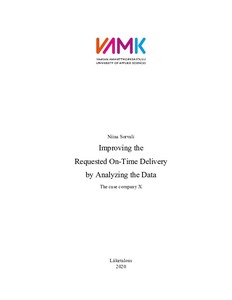Improving the Requested On-Time Delivery by Analyzing the Data: The case company X
Sorvali, Niina (2020)
Lataukset:
Sorvali, Niina
2020
All rights reserved. This publication is copyrighted. You may download, display and print it for Your own personal use. Commercial use is prohibited.
Julkaisun pysyvä osoite on
https://urn.fi/URN:NBN:fi:amk-2020112323728
https://urn.fi/URN:NBN:fi:amk-2020112323728
Tiivistelmä
In Autumn 2019, the case company utilized the global data mining tool, Celonis, to measure the Requested on-Time Delivery, ROTD. The tool measures how well the organization is able to meet the customer requested delivery date, and it is taking the data directly from company’s ERP- system. The difference between the requested delivery date and the actual delivery date is notable. Hence, the goal of this thesis is to analyze the data from the Celonis tool, and to find out the gaps affecting the ROTD. The aim is also to find the improvement areas to better meet the customer requested delivery time, and to increase the ROTD. There is a globally indicated target for ROTD%, which this thesis is aiming to support also. This study was carried out by building a theoretical understanding of the order-to-delivery process, the delivery performance measurement and, in addition; a small portion of the continuous improvement. Later, all these topics were combined into the theoretical framework, which was supporting the empirical part of the study. This case study focused only on the case company’s data analyze, and the case study used both quantitative and qualitative methods. The secondary data was first analyzed to find out the reasons to the current ROTD level, and with the help of interviews, the primary data was collected to have a deeper understanding of the entirety and propose some improvement ideas. The secondary data analysis shows that the reason for ROTD gaps varies a lot between customers, so customer specific improvement actions must be implemented. Based on the results of primary data analyses, the correct system data at Local Sales Units (LSU’s) and Regional Distribution Centers (RDC’s) plays a significant role in ordering sub-process, and on the other hand, strong cooperation and clear instructions would be the key to improve also the biggest gaps in ROTD.
